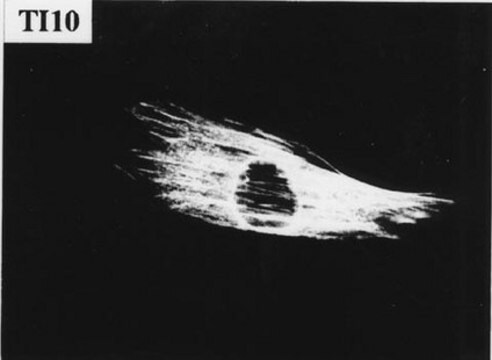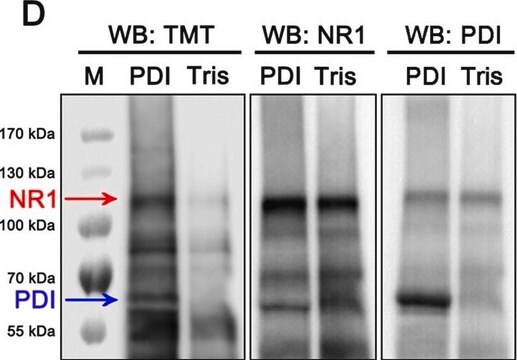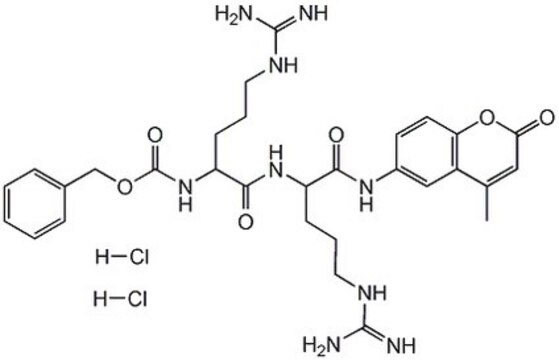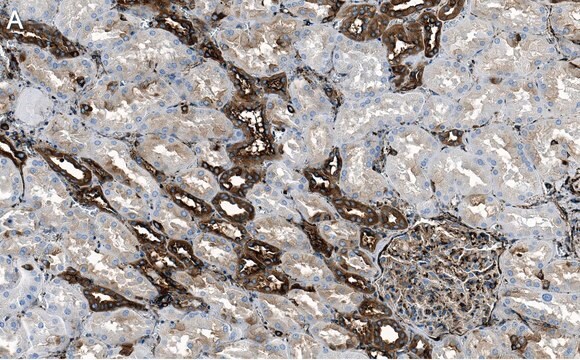MAB1678
Anti-Filamin A Antibody, clone PM6/317
ascites fluid, clone PM6/317, Chemicon®
Sinónimos:
Alpha-Filamin, Filamin I, Endothelial Actin-binding Protein, ABP-280, Nonmuscle Filamin
About This Item
Productos recomendados
biological source
mouse
antibody form
ascites fluid
antibody product type
primary antibodies
clone
PM6/317, monoclonal
species reactivity
human, rabbit, rat, guinea pig, chicken, mouse
manufacturer/tradename
Chemicon®
technique(s)
immunofluorescence: suitable
immunohistochemistry (formalin-fixed, paraffin-embedded sections): suitable
immunoprecipitation (IP): suitable
western blot: suitable
isotype
IgG1
NCBI accession no.
UniProt accession no.
shipped in
wet ice
target post-translational modification
unmodified
Gene Information
human ... FLNA(2316)
mouse ... Flna(192176)
General description
Specificity
Immunogen
Application
1:1000-1:4000. Because of the large size of the unprocessed forms of filamin, 4-7% PAGE gels and proteinase inhibitors are recommended.
Immunofluorescence:
1:50-1:200 dilution from a previous lot was used. Suitable for staining both frozen and paraffin embedded tissues (at lower dilutions). Microwave-citrate buffer antigen retrieval method recommended for paraffin sections.
Immunoprecipitation:
A previous lot was used on immunoprecipitation. Suggested lysis buffer is PBS with 0.5% triton X-100 with proteinase inhibitors (note for full length filamin include calpain inhibitors). 5 microliters of antibody for every 300-500 μL of cell lysate (200-500 μg/mL total protein is suggested. Incubation is 1 hour RT or overnight 4C; Protein A/G agarose beads or rabbit anti-mouse secondary capture antibody is recommended for best recovery. 4-8% acrylamide gels are recommended for full length filamin or the 190 kDa fragement visualization.
Optimal working dilutions must be determined by end user.
Cell Structure
Cytoskeleton
Quality
Western Blot Analysis:
1:500-1:4000 dilution of this lot detected Filamin A on 10 μg of Jurkat lysates. Because of the large size of the unprocessed forms of filamin, 4-7% PAGE gels and proteinase inhibitors are recommended.
Target description
Physical form
Storage and Stability
Handling Recommendations: Upon first thaw, and prior to removing the cap, centrifuge the vial and gently mix the solution. Aliquot into microcentrifuge tubes and store at -20°C. Avoid repeated freeze/thaw cycles, which may damage IgG and affect product performance.
Analysis Note
Positive control tisse: skin, jurkat cell lysate.
Other Notes
Legal Information
Disclaimer
¿No encuentra el producto adecuado?
Pruebe nuestro Herramienta de selección de productos.
Optional
Storage Class
12 - Non Combustible Liquids
wgk_germany
nwg
flash_point_f
Not applicable
flash_point_c
Not applicable
Certificados de análisis (COA)
Busque Certificados de análisis (COA) introduciendo el número de lote del producto. Los números de lote se encuentran en la etiqueta del producto después de las palabras «Lot» o «Batch»
¿Ya tiene este producto?
Encuentre la documentación para los productos que ha comprado recientemente en la Biblioteca de documentos.
Nuestro equipo de científicos tiene experiencia en todas las áreas de investigación: Ciencias de la vida, Ciencia de los materiales, Síntesis química, Cromatografía, Analítica y muchas otras.
Póngase en contacto con el Servicio técnico








